Social Care Services, Scotland, 2014
Information on Home Care Services, Direct Payments, Community Alarms and Telecare, Meals services and Housing Support Services.
This document is part of a collection
5. Analysis of Social Care data by relative deprivation
(data under development)
This section presents analysis of Home Care and Direct Payment information, broken down by the relative deprivation of the areas in which individuals live. This analysis is new to the 2014 publication and remains preliminary. Results are only presented for working aged adults (clients aged 18 to 64) and Older People (clients aged 65+), due to the relatively small numbers of young person clients (aged 0-17).
The relative deprivation within Scotland of the small area (DataZone) in which an individual lives is defined by the overall ranking of that DataZone within the 2012 Scottish Index of Multiple Deprivation (SIMD 2012). Results are presented by breaking these DataZones down into five 'quintiles'. Quintile 1 (Q1) represents the 20% most deprived DataZones in Scotland, Quintile 2 (Q2) the next most deprived 20% and so on, until Quintile 5 (Q5) represents the 20% least deprived DataZones.
Only Social Care Survey clients for whom full Post Code information is available are included in this analysis, as without this information the link to DataZone cannot be made. Such a linkage is only possible for 98.0% of the 148,300 individuals present on the 2014 Social Care Survey. Over half of the clients for whom linkage was not possible were from one Local Authority (Clackmannanshire), who did not submit full Post Code information for any of their clients. The lack of complete data coverage introduces a degree of uncertainty into the results of this analysis.
When considering the numbers of individuals receiving a certain service, or the total hours of Home Care / values of Direct Payments received, results are presented per capita of the population of each SIMD 2012 quintile1. This rate-based approach is necessary, as the demographic effects of relative deprivation mean that population is not evenly distributed amongst the SIMD 2012 quintiles, especially when considering older age groups.
5.1. Home Care services
Figure 26 shows that the per-capita rate of adult Home Care clients increases with increasing relative deprivation. Clients aged 18 to 64 living in the 20% most deprived areas (Q1) are around three times more likely than those living in the 20% least deprived areas (Q5) to be in receipt of Home Care services. Clients aged 65+ living in the 20% most deprived areas (Q1) are around twice as likely as those living in the 20% least deprived areas (Q5) to be in receipt of Home Care.
Based on the March 2014 data, 82% of Home Care clients are aged 65+ (Figure 9). This is reflected in Figure 26, with the rates per population being much higher for clients aged 65+ than for clients aged 18 to 64. Therefore, age remains the most significant factor when it comes to utilisation of Home Care services. However, relative deprivation is also seen to have an effect on service utilization. This pattern is likely to reflect relatively greater need for Home Care services in more deprived areas.
Figure 26: Clients receiving Home Care services, per capita population, by SIMD 2012 quintile, 2014
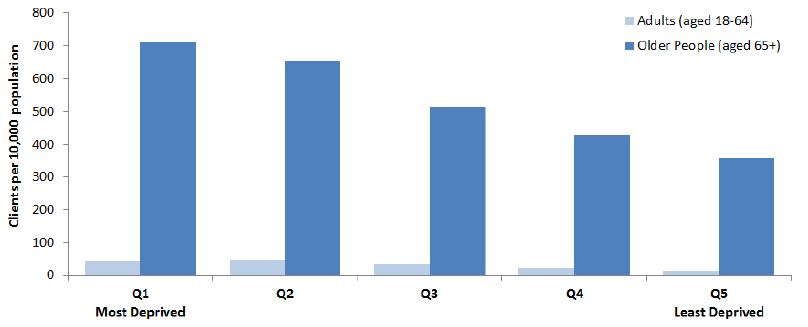
Source: Social Care Survey 2014.
Population data: National Records for Scotland special area mid-year population estimates 2013 (latest available).
Figure 27 shows that the average (median) number of hours per week of Home Care received by clients aged 65+ shows no variation with relative deprivation, whereas clients aged 18-64 living in less deprived areas receive, on average, slightly greater numbers of hours of Home Care than those in the more deprived areas.
Figure 27: Average hours of Home Care services per week, by SIMD 2012 quintile, 2014
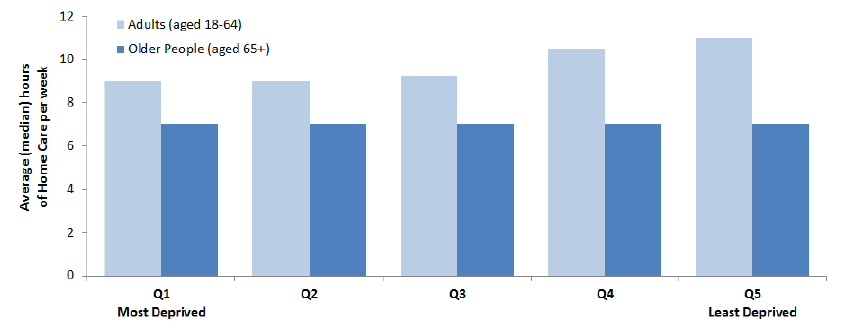
Source: Social Care Survey 2014.
Figure 28 shows that the total amounts of adult Home Care provided per-capita population in more deprived areas is greater than that provided in the less deprived areas. In the case of clients aged 18 to 64, these results show that the pattern of increasing number of Home Care clients with increasing relative deprivation (Figure 26) has more of an effect on the total hours provided than the opposing pattern seen in the average amounts of care (Figure 27).
Figure 28: Total hours of Home Care services, per capita population, by SIMD 2012 quintile, 2014
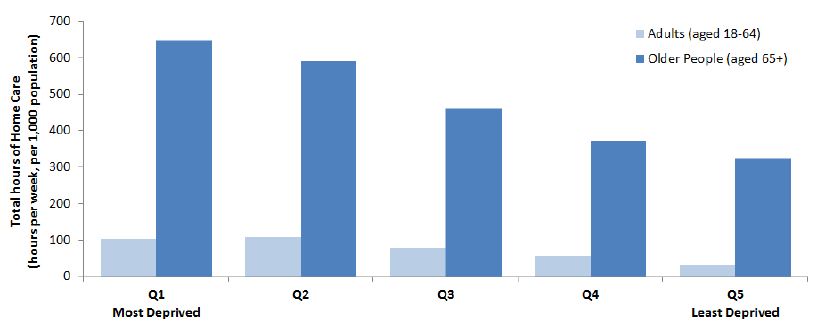
Source: Social Care Survey 2014.
Population data: National Records for Scotland special area mid-year population estimates 2013 (latest available).
5.2. Direct Payments
Figure 29 shows that the per-capita rate of Direct Payment clients aged 18-64 in 2013-14 has no clear relationship with relative deprivation, whereas the per-capita rate of clients aged 65+ increases with decreasing relative deprivation. Clients aged 65+ living in the 20% least deprived areas (Q5) are around three times more likely than those living in the 20% most deprived areas (Q1) to be in receipt of a Direct Payment.
Based on the 2013-14 data, only 39% of Direct Payment clients are aged 65+ (Figure 10). However, it is only for clients in this age group that relative deprivation is seen to have a substantial relationship with rates of Direct Payment receipt. This pattern may indicate a situation in which existing clients in less deprived areas have been more aware of Direct Payments.
Figure 29: Clients receiving Direct Payments, per capita population, by SIMD 2012 quintile, 2013-14
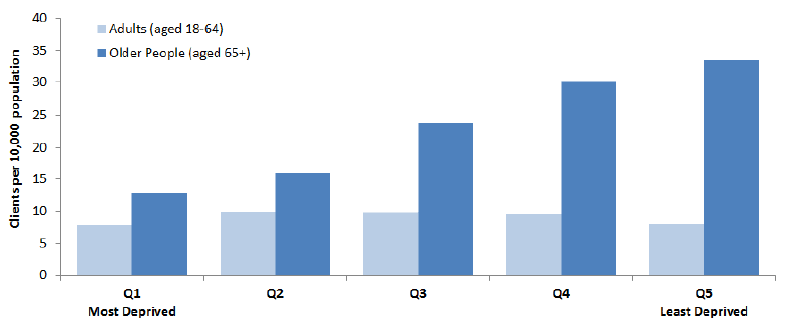
Source: Social Care Survey 2014.
Population data: National Records for Scotland special area mid-year population estimates 2013 (latest available).
Figure 30 shows that the average (median) value of Direct Payments received by clients aged 18 to 64 has no clear relationship to relative deprivation, whereas the average value received by clients aged 65+ is higher in more deprived areas. The average value of Direct Payments received by clients aged 65+ living in the 20% most deprived areas (Q1) was £7,800 (to nearest £100), whereas the average value received by those living in the 20% least deprived areas (Q5) was £5,600. The pattern seen for clients aged 65+ is likely to reflect relatively greater care needs in more deprived areas. Figure 30 also reflects the results seen in Table 3 and Table 5, that the average Direct Payment values received by clients aged 18 to 64 are higher than those for clients aged 65+, reflecting the generally more complex care needs of younger adults.
Figure 30: Average value of Direct Payments, by SIMD 2012 quintile, 2013-14
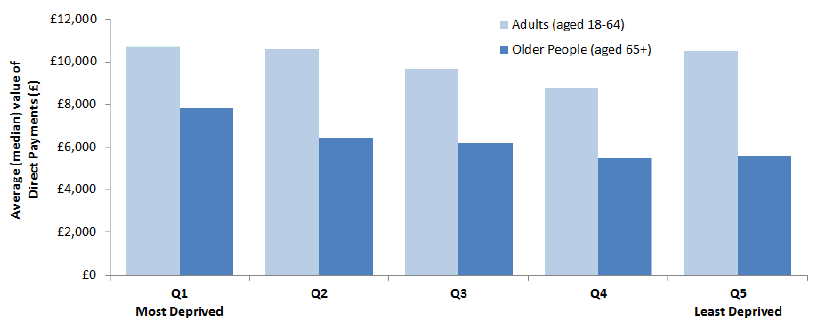
Source: Social Care Survey 2014.
Figure 31 shows that the rate of total expenditure on Direct Payments per-capita population aged 18 to 64 has no clear relationship with relative deprivation, whereas the rate per-capita population aged 65+ is higher in less deprived areas than in more deprived areas. Total expenditure on Direct Payments per-capita population aged 65+ living in the 20% most deprived areas (Q1) was £16 per head of population (to nearest £ per head), whereas total expenditure for those living in the 20% least deprived areas (Q5) it was £28 per head. In the case of clients aged 65+, these results show that the effect on total expenditure of having more Direct Payment clients in less deprived areas (Figure 29) is greater than the opposing pattern seen in the average payment amounts (Figure 30).
Figure 31: Total value of Direct Payments, per capita population, by SIMD 2012 quintile, 2013-14
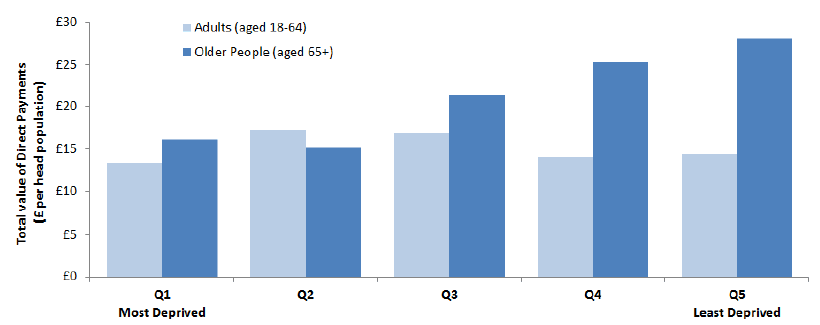
Source: Social Care Survey 2014.
Population data: National Records for Scotland special area mid-year population estimates 2013 (latest available).
5.3. Comparison of Home Care and Direct Payments results
For working aged adults (18-64), total Home Care provision per-capita population increases with increasing relative deprivation (Figure 28), whereas total Direct Payment expenditure per-capita population (Figure 31) shows no clear relationship with relative deprivation. For older people (aged 65+), total Home Care provision per-capita population increases with increasing relative deprivation (Figure 28), whereas total Direct Payment expenditure per-capita population decreases with increasing relative deprivation (Figure 31).
When comparing the trends seen for older people (aged 65+) it must be remembered that many more individuals of this age make use Home Care services (50,440 clients) than receive Direct Payments (2,310 clients). If these two services were to be taken collectively, the trend of increasing utilization in more deprived areas seen for Home Care would dominate the overall pattern.
For the 2013-14 data, the majority of the Direct Payment clients are likely to be individuals who have requested this method of support from their Local Authorities. The roll out of SDS means that, from next year, all Social Care clients will be offered a choice as to how they wish to receive their support and services. Direct Payments will form one of the options to be offered and hence the numbers of such clients might be expected to increase significantly over coming years. It will be interesting to assess if (and how) such an expansion of the client base alters the present relationships between receipt of Direct Payments, especially by clients aged 65+, and relative deprivation.
Contact
Email: Steven Gillespie
There is a problem
Thanks for your feedback